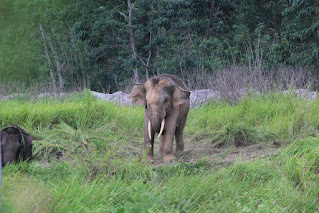Elephants are the largest land animals on our planet, easily recognizable by their distinctive features, such as wide ears, long trunks, column-like legs, and large bodies. In Asia, the only species of elephant is Elephas maximus, commonly known as the "Asian elephant." Within this continent, there is a subspecies of Asian elephants that inhabit the island of Sumatra.
Sociality is a prominent aspect of elephant life, particularly among female elephants. They are well-known for their strong sense of family. Female elephants form close-knit family units consisting of several related females and their offspring. Within an elephant herd, there are interactions among these family units that form the basic structure of the elephant community. Elephant herds are not merely random collections; they consist of one or more elephant families with closely related individuals spanning several generations.
Typically, each elephant family is led by an older female considered to be the matriarch. The elephant family structure includes a hierarchical system that determines the ranking of each individual. Although disputes among female elephants can occur, each individual knows their rank, allowing them to form harmonious, stable, and strong family groups.
Elephant herds do not stay together all the time. During the day, they often disperse over considerable distances to forage for food, only to reunite later. The size of elephant herds can vary over time, but the core family group is relatively small, usually comprising fewer than 30 individuals, consisting of grandmothers, female offspring, and their progeny. This family structure remains relatively stable over time.
However, larger elephant herds can form when two or more families join together and travel as a single unit for a certain period. If conditions are favourable, a large herd of 70 or more elephants can be observed, which is sometimes referred to as a "clan." These large herds may travel together for days, weeks, or even months. Eventually, they will split into smaller groups, either for reorganization or to continue their movements as separate families. This behaviour is known as fission-fusion behaviour and is a common feature among elephant communities.
Although research on fission-fusion behaviour in elephant populations is still in its early stages, there is substantial evidence indicating that this flexible structure is a common phenomenon in elephant communities. Fission-fusion behaviour allows them to adapt to different environments and situations while forming extensive and complex social connections.
Understanding the behaviour and social structure of elephants is crucial for conservation efforts. Loss of natural habitat and other threats have significantly reduced elephant populations in the wild, particularly on the island of Sumatra. With a deeper understanding of elephant social life, it is hoped that more effective conservation strategies can be developed to protect this species from extinction. As one of the vital contributors to ecosystems, preserving elephant populations will have positive impacts on the environments they inhabit. Through sustained conservation efforts and a comprehensive understanding of their social dynamics, we can ensure that elephants continue to be an irreplaceable part of Earth's biodiversity.


No comments:
Post a Comment